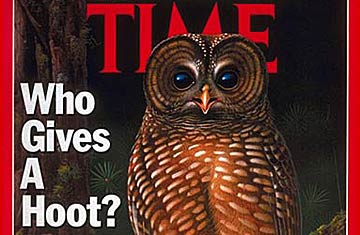
(8 of 9)
Oliver is enchanted by the owls' trusting ways, their grace and their attention to their young. He worries about their future, seemingly dependent as they are for both prey and nesting sites on old-growth forests. But Oliver and others have observed that it is not the age of the forest that appears to be critical to the habitat of the owl, but rather the structure and character of the forest. He and other biologists hope that one day they will be able to identify those key components and, by preserving them in reforested tracts, both widen the owls' habitat and open the way for a resumption of timbering on a selective basis. But the owl is not alone in the forest. As an "indicator species," its well-being is a measure of how other creatures and the ecosystem as a whole are faring. "The spotted owl is almost certainly just the tip of the iceberg," says the Forest Service's Franklin. "There are probably dozens of other species just as threatened as the owl."
The dispute over the owl has festered more than 15 years, a period in which the ancient forests receded ever farther and the timbering continued largely unabated. Efforts to find a solution were thwarted by the power of the timber industry, the bungling and inertia of the federal bureaucracy and the stridency of an environmental movement as quick to alienate as to persuade. But the conflict should never have reached the current crisis point. Forest ranger Schindler believes the coming economic turmoil might have been averted if the Government had weaned industry from its dependence on old growth by gradually reducing the level of harvesting. Instead the industry has been allowed to enjoy record harvests in recent years.
U.S. Forest Service biologist Eric Forsman, who has studied the owl since 1968, believes it was the strategy of the federal agencies to stall for time by continually asking for more studies on the owl. "I've seen how the games are played," says Forsman. BLM in particular ignored repeated alarms. As < early as 1976, BLM biologist Mayo Call warned his superiors that unless swift action was taken to protect the owl, it might one day have to be put on the endangered-species list, curtailing timber harvests on federal lands.
And the U.S. Fish and Wildlife Service, which is charged with protecting species, refused to call for the owl to be listed as endangered until a federal court in 1988 judged that refusal to be "arbitrary and capricious." Later the General Accounting Office discovered that Fish and Wildlife officials had rewritten portions of a major study, expunging critical references suggesting the owl was endangered. One biologist said he felt pressured to "sanitize the report." For years, economics and politics, not biology, have controlled the decisions of BLM, the Forest Service and Fish and Wildlife.
